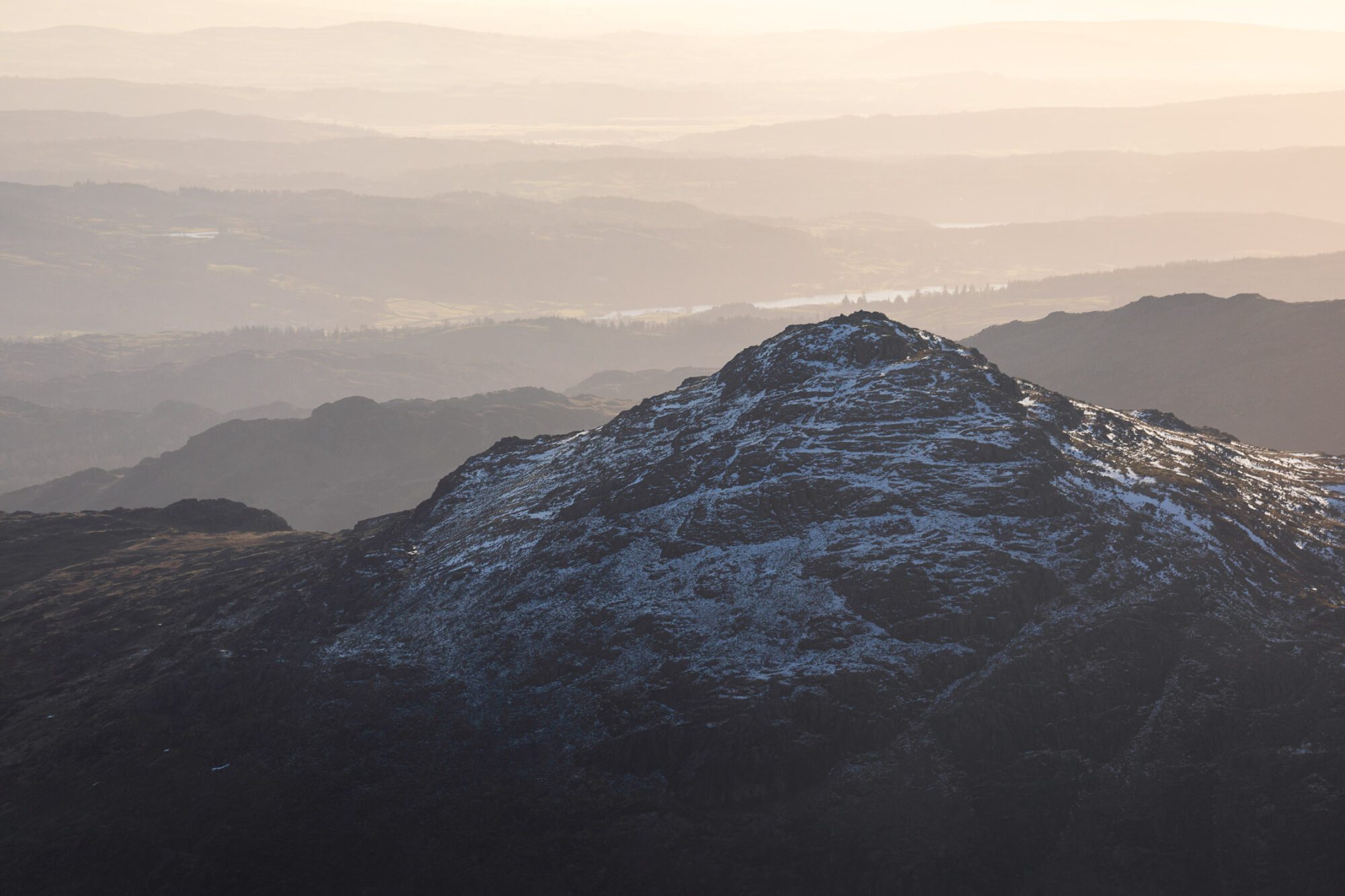Bowfell. Where do I start? The iconic Bowfell is located in Great Langdale (southern Lake District) and stands at a modest 902m, making it the sixth-highest mountain in the Lake District. I’ve hiked up Bowfell more times than I can count. It has a unique charm that keeps you going back for more. Its summit views are nothing short of spectacular, offering breathtaking 360-degree vista views of some of the Lake District’s most beautiful scenery.
It has long been a mission of mine to photograph the beauty of the views from Bowfell. With every ascent, I learn more about the terrain and the intimate details which define Bowfell. And then there’s the light, understanding the direction of light at specific times of the year and its impact on the surrounding landscape. I’m continuously learning and applying new-found knowledge in the hope that one day, I can capture that dream photograph.
Until recently, there was one set of conditions I had yet to experience on Bowfell. Full winter conditions. By this, I mean snow and ice, and lots of it! There’s just something about full winter conditions on mountainous terrain. Wintry landscapes can be incredibly photogenic and provide exciting opportunities for landscape photographers. Unfortunately, we don’t seem to get long-lasting winters like we used to. However, a couple of weeks ago, I finally got my chance. I had one of the most surreal mornings on Bowfell I have ever experienced. Glorious golden sunrise light, beautifully diffused by the haze of low clouds and mist. I hope this write-up does it justice!
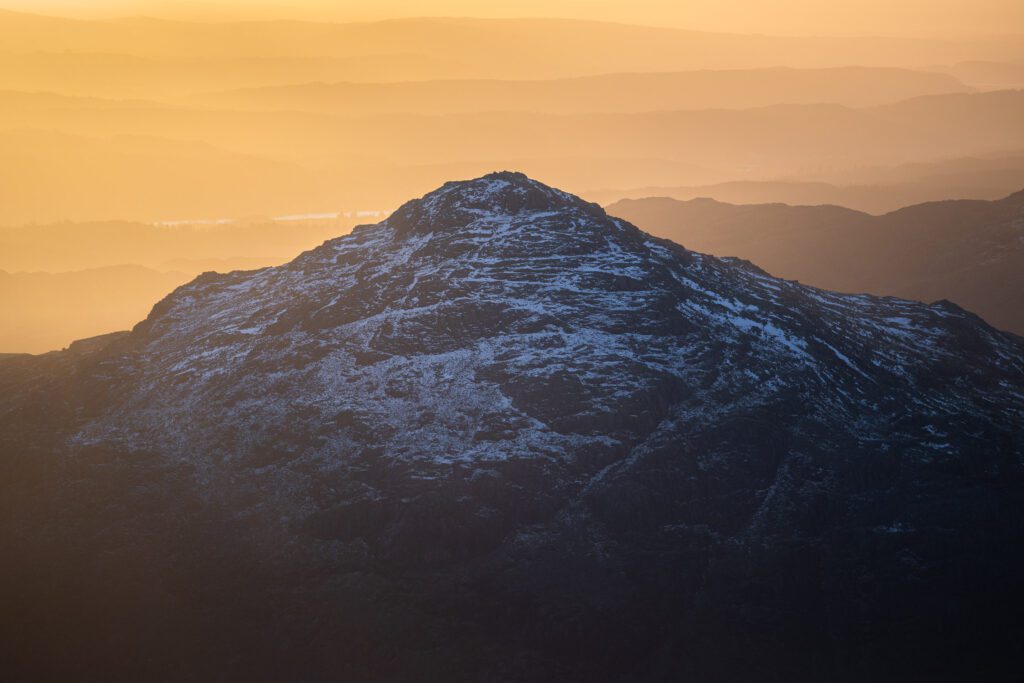
TLDR – my favourite image of the trip. A breathtaking view of Pike O’Blisco, beautifully complimented by glorious sunrise light and the delicate layers of the distant landscape. I reveal the phenomenal build-up to this image and more throughout this post.
Bowfell. We Meet Again, Old Friend
A couple of weeks ago, I returned to the iconic Great Langdale to climb Bowfell under full winter conditions. I’m no stranger to Bowfell; it’s one of my favourite summits in the Lake District, offering spectacular vista views across Great Langdale. However, I hadn’t climbed it under full winter conditions, and to say I was excited is an understatement.
Dynamic Conditions Following the Tail-End of Storm Eowyn
In the days leading up to my trip, Storm Eowyn had passed, and the tail-end delivered a generous dusting of snow to peaks above 500m. Just as the tail-end had about cleared the UK, a perfect weather opportunity presented itself. I didn’t obsess too much over the forecast. All I needed to know was that there was zero chance of precipitation and good visibility. Higher fells tend to become lost within the clouds, and there’s nothing worse than climbing 900m to be met by a stubborn cloud base and zero visibility. Happy with the forecast, I packed my gear and prepared for the photography adventure.
Arriving in Great Langdale, Southern Lake District
Wednesday 29th January
I arrived at Stickle Ghyll National Trust car park ridiculously early, allowing extra time to climb Bowfell in time for sunrise. On an average day, the journey to the summit is pretty straightforward, one and a half hours or so, with a relatively decent fitness level. This time, however, I knew that the deep snow and ice would slow me down somewhat. Catering for this made the journey much more relaxed and less of a panic scramble to catch the sunrise. I left the car park around 05:30 with a fully loaded pack of camera gear and winter equipment.
For anyone interested, my backpack weighed just under 15kg. Inside, I had my camera equipment, plenty of water, an ice axe, ice spikes, multiple layers of clothing, high-energy snacks and the usual safety equipment (first aid kit, emergency shelter, power bank). Exiting the car park, I headed for Stool End Farm, the start of the trail for the morning’s adventure.
I love the walk from Stickle Ghyll car park to Stool End Farm (the start of the relentless hike up The Band); it’s a nice warm-up for the hike ahead. Weather conditions were as forecast: cold with a sharp wind chill at ground level. As someone whose body runs hot, the most challenging thing about winter hiking is maintaining a cool body temperature. You want to avoid sweating in winter conditions. I always start with baselayers and layer up from there as required.
Heading up Bowfell via The Band
Walking up The Band was pretty eventless for the first 400 metres. It was pitch black, and there wasn’t much to see other than the trail ahead illuminated by my headtorch. Occasionally, the beam of my headtorch would catch the odd ‘Herdy’ (Herdwick Sheep) resting in various spots along the trail. The nice thing about the first slog is that you’re well protected from those bitter north and northwesterly winds.
The First Photograph of the Morning
Reaching the 500m ascent line, I came across the first patches of snow and ice. From this point onwards, the snow and ice increased with every gain in altitude. Eventually, the ice became enough of a concern to warrant putting on my ice spikes. By this point, the area had opened up, and the bitter winds whipped around me. Starting to feel the chill, I also took the opportunity to layer up with my down jacket and windproof layers. During this time, I seized the chance to bag the first photograph of the morning. Nothing too special, just an imposing view of Crinkle Crags sporting its spectacular winter coat during the early stages of Blue Hour.
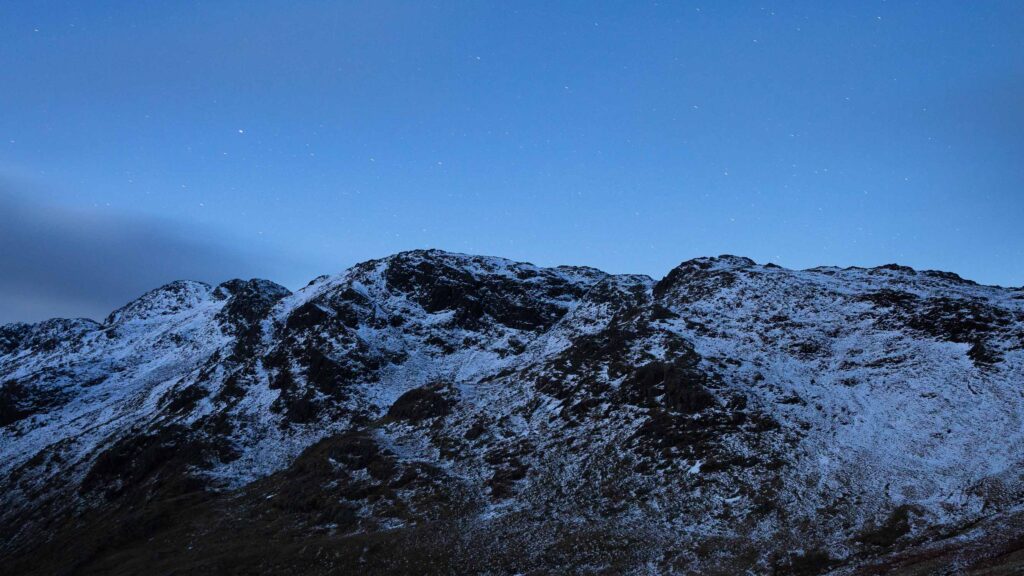
I honestly have no idea how this photo turned out so sharp. This was a 30-second exposure at ISO 1600 without a tripod! I balanced my camera on a rock, which was somewhat shielded from the increasingly strong winds. Anyway, I’m glad it turned out. This is the spectacular view of Crinkle Crags from around 500m ascent. What a sight. I will never tire of being surrounded by breathtaking mountains, especially with their winter coats on!
With the first photograph of the morning captured, I continued to push on towards the summit. Just below the summit of Bowfell, the snow was waist-deep in places, incredibly taxing conditions to push through. Little did I know, however, that I was minutes away from witnessing one of the most atmospheric sunrises I had ever experienced.
Never Forget to Look Behind You!
You’ve probably heard this a lot, but it’s worth reiterating. NEVER forget to look behind you. As I neared the summit, sunrise to the southeast was an explosion of glorious golden colours. Instead of reaching the summit, I decided to turn around and backtrack a few hundred metres to a viewpoint overlooking Three Tarns. Three Tarns is, as it sounds, a grouping of three tarns that lay at the top of The Band on the col between Crinkle Crags and Bowfell. Happy with my viewpoint, I quickly pulled my camera from my backpack and got to work.
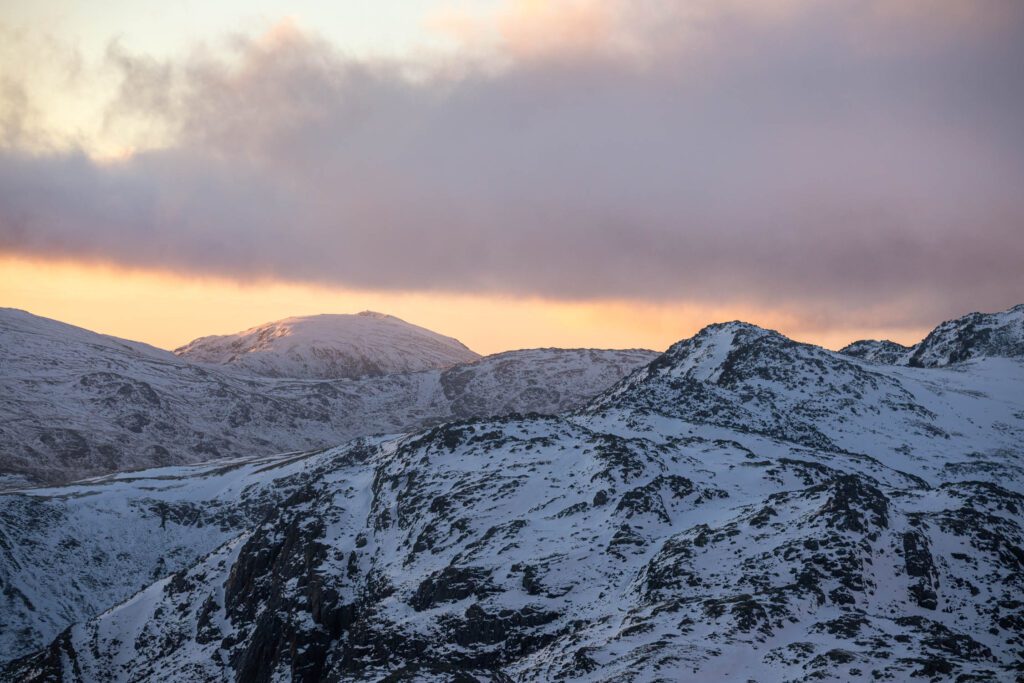
A quick snap of the view behind me as I neared the summit of Bowfell. If this doesn’t reinforce the message of never forgetting to look back, I don’t know what does.
A Sunrise From Bowfell Like No Other
As the sun began to rise, the weather decided to throw a curveball. A band of low clouds/mist had decided to whip through from the north/northwest. This rendered the visibility from the summit of Bowfell zero. My choice to backtrack slightly now seemed like a great call. However, coupled with the strong wind, the cloud and mist made light work travelling across Langdale Valley and began to shroud the landscape. This effectively diffused the sunrise light and created some of the most dramatic golden light I had ever seen.
Due to the visibility to the north and west being obscured by clouds, I had no choice but to tackle the dynamic scenes in front of me. At times, the entire landscape was shrouded in mist, and visibility was poor. Given the situation, I knew this wasn’t the best time for wide-angle photography. I quickly switched lenses from my Canon EF 24-70mm F2.8L to my Canon EF 70-200mm F4L and waited patiently. My thought process was to pick out small, detailed scenes illustrating the phenomenal conditions I was experiencing.
Picking Out Intricate Details With a Telephoto Lens
Here’s a quick photograph of the view across Langdale Valley to Pike O’Blisco and beyond. Just look at that light, mind-blowing yet incredibly dynamic. This photograph was taken at 118mm with a negative 2-stop exposure compensation, and the highlights were still very much blown. I didn’t have the facility to compensate any further without risking losing detail in the shadows (no tripod to exposure bracket the scene). With this in mind, I worked on removing the problematic highlights from my composition. This formed the basis for my subsequent photograph, a closer and more intimate view of the Pike O’Blisco.

You’ll notice in the photograph above the stunning layers behind Pike O’Blisco. This was created by a lingering haze of mist and low clouds moving southeast across the Lake District. I wanted the layers to be a strong feature, complimenting the gorgeous view of Pike O’Blisco. With this in mind, I zoomed in further in small increments until I was happy that I had removed the issue of blown highlights. What came next was possibly my favourite landscape photograph of winter so far.
Photo of the day from a Mind-blowing Morning on Bowfell
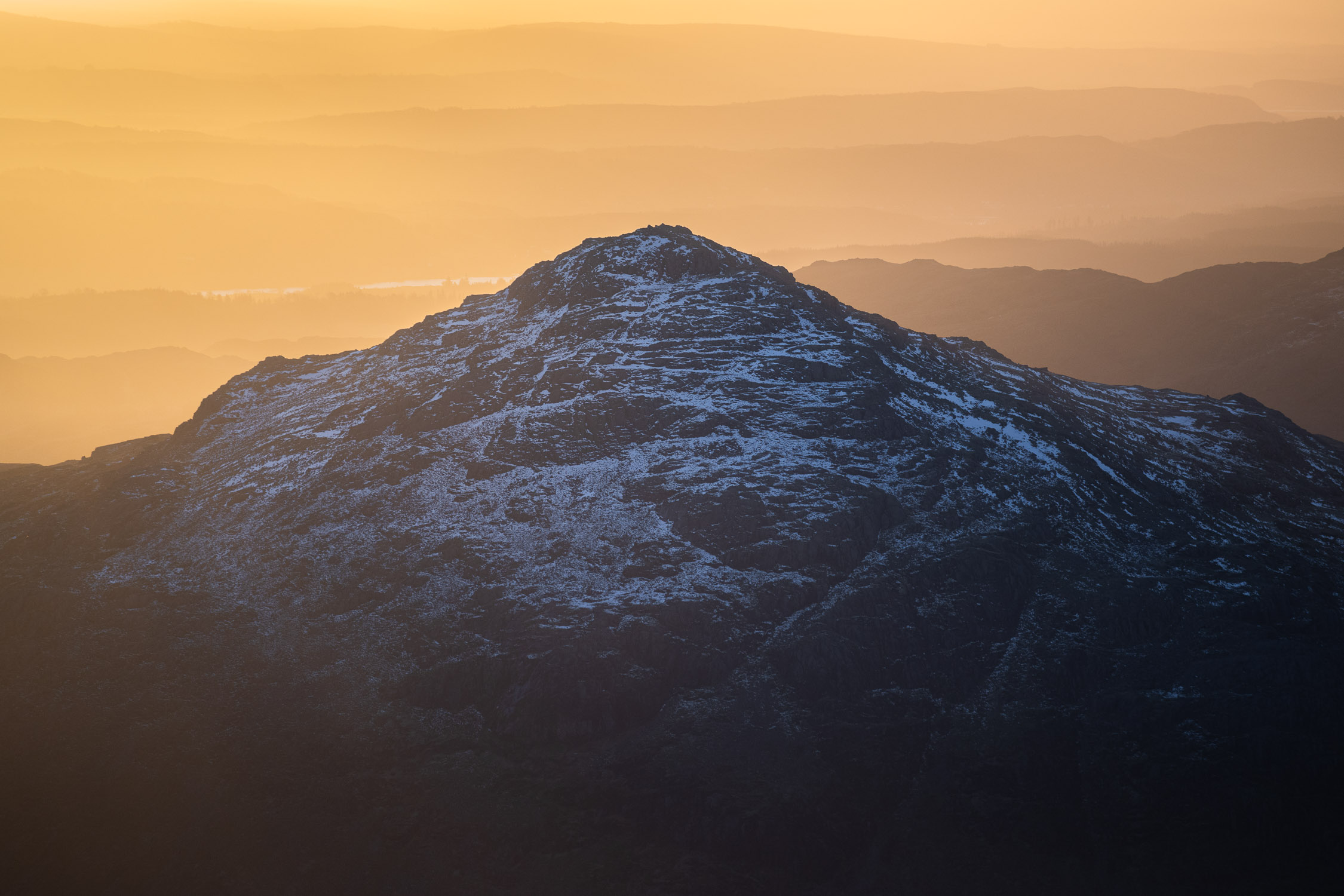
This heavenly view was captured at 200mm. I’m unbelievably happy with how this turned out. The glorious light, beautiful layers, and snowcapped Pike O’Blisco – does it get any better than that? I also love that the foreground still has an element of haze created by the passing mist. It helps add softness and atmosphere to the scene. For much of sunrise, the view was lost to cloud. However, an opportunistic break in the clouds revealed the view I had hoped for. At that point, instinct took over, and I seized the moment.
I’ll pop an example of the obscured view of the landscape below. Hopefully, this helps to emphasise just how surreal the conditions were that morning.
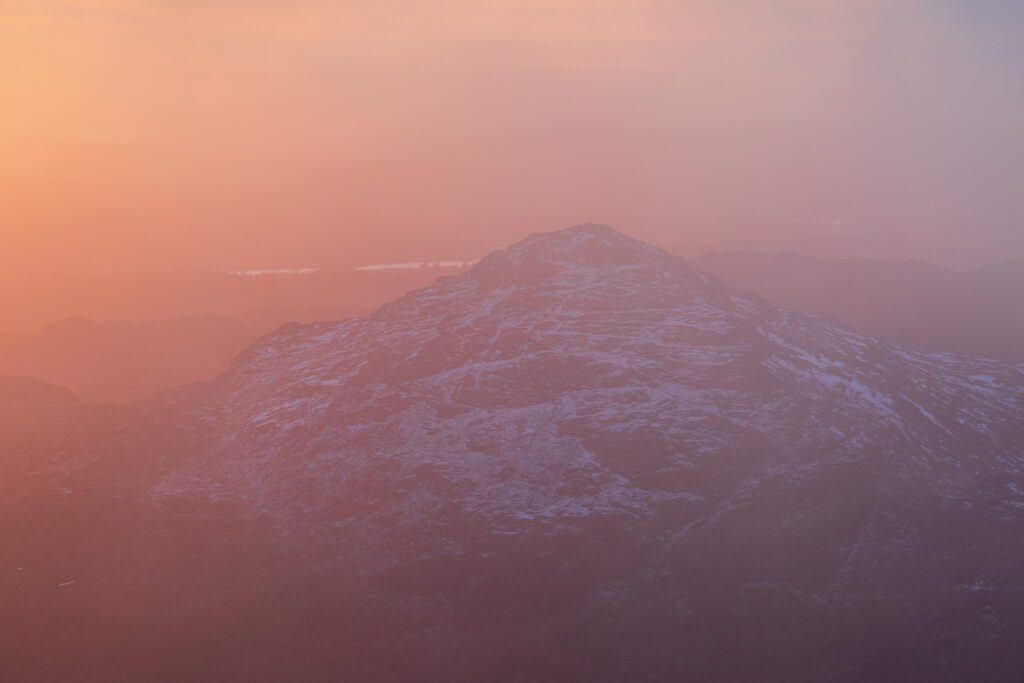
Above: The waiting game. Here, Pike O’Blisco is barely visible through an onslaught of low clouds and haze fueled by the strong winds. Manual focus was the only reliable way to ensure sharp photographs throughout the morning.
Telephoto Lens Compression Explained
Before I move on, I feel it’s important to note that the vibrant sunrise colour is very much real. In fact, I had to desaturate the colours in post-processing to make them a little less dominant. For anyone who would like to know how this was possible, it is the result of using a telephoto lens. Using a telephoto lens provided me a more compressed view of a small area, close to the direction of the sunrise. Had I chosen to shoot at a wider angle, you would have seen the vibrant colours gradate to dramatically less saturated colours along the far edges of the frame.
Switching to a Wide-Angle Lens for Vista Views of Great Langdale
Happy with the telephoto capture, I switched to my wide-angle lens to capture a vista view of the dramatic morning. I’ll be honest; it wasn’t easy. I struggled to find dominant foreground features which complimented the view in front of me. I was also reluctant to veer too far off-piste. The area I had chosen to base myself on was a small scramble section. I knew I was safe where I was, but you just can’t be too sure what’s under the snow. I had my ice axe to spot-test my footing, but still, it’s just never smart to take risks, especially as a solo hiker/photographer. Instead, I decided to play it safe and make do with what I had.
The Challenge of High Dynamic Range
My primary focus was to capture the stunning view of Crinkle Crags and Wetherlam in full winter conditions. The tricky part was tackling the high dynamic range of the scene without having the ability to accurately exposure bracket the scene. I didn’t have my tripod with me. The combination of wind and wind chill meant I wasn’t confident in my ability to hold the camera steady enough to capture multiple exposures.
I won’t go into too much detail about each of the following photographs. Instead, I’ll pop a small caption under each detailing the settings used to capture the image.
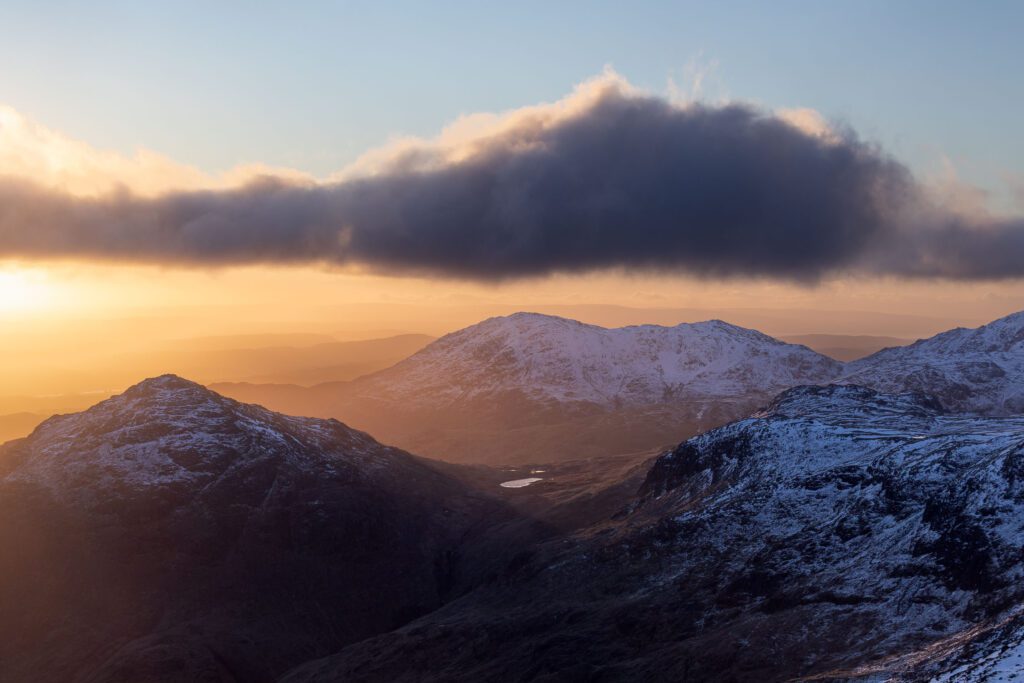
Above: I quite like this shot. It was captured at 70mm using my Canon EF 24-70mm F2.8L lens. This was taken very much at the peak of the sunrise during a brief window of increased visibility. It was a tricky one to expose correctly. I pushed the shadows as far as I felt comfortable, doing my best to reduce clipped highlights. I love the shaft of light passing between Pike O’Blisco and Wetherlam with Red Tarn in the centre of the frame. The blue sky was quite an unusual touch, not something you would typically associate with such vibrant sunrise colours.
Below: This final photograph was taken during the final moments of Golden Hour. The golden colours had all but faded as the sun rose throughout the morning. I think this shot illustrates how difficult conditions were for photography despite being so spectacular to witness. A mix of deep shadows, strong highlights, haze, and not to mention the wind chill and temperature. In hindsight, it wasn’t really a morning for wide-angle photography. Picking out details with the telephoto lens was definitely the smarter play.
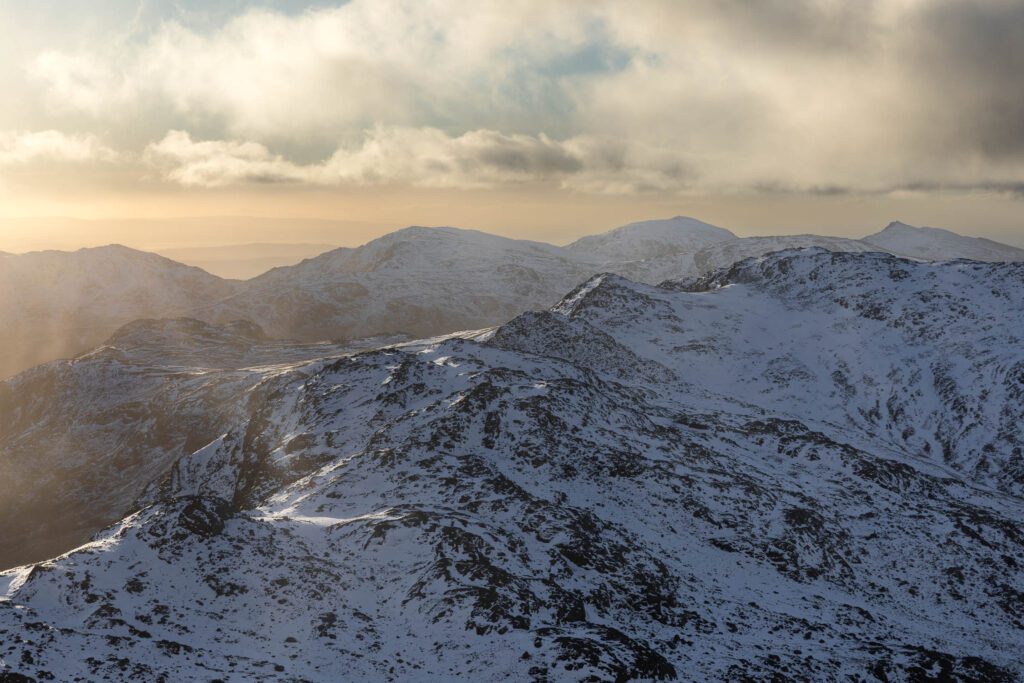
Leaving Bowfell, one last Photograph Can’t Hurt!
I couldn’t believe it when I realised it was almost noon. I’d been up around the summit of Bowfell for over 4 hours. To be fair, after sunrise, I did treat myself to a nice break in a sheltered area where I enjoyed breakfast. As much as I could have stayed up on Bowfell, I decided it was time to head back down.
Before starting my descent, I grabbed my camera and captured one last photograph. My focus had returned to the scene I’d captured earlier that morning. The difference was that the sun was much higher, and more of the distant landscape was visible. The scene was delicately embraced by a beautifully soft haze, which complemented the intricate details of Windermere and beyond. Gorgeous, and what a way to end the trip!
I couldn’t decide which version I liked best, colour or monochrome. I’m not typically a fan of monochrome, but I think it works well in this scenario. I would love to hear your thoughts. Which version do you prefer?
Coming soon…
Exciting Times and Winter Transitions to Spring
Despite being under a high-pressure weather system, the weather hasn’t been great for landscape photography recently. Anti-cyclonic murk is the technical term. The promise of one last hoorah for winter has all but fallen apart as we look set to end winter with a period of mild weather. However, as sad as I will be to see the back of winter, we’re entering that exciting transition between winter and spring. Daylight hours are getting longer, and nature is beginning to awaken. My focus over the next few weeks is to photograph and illustrate the changing of the seasons. I’m excited to get stuck in and can’t wait to share the results.
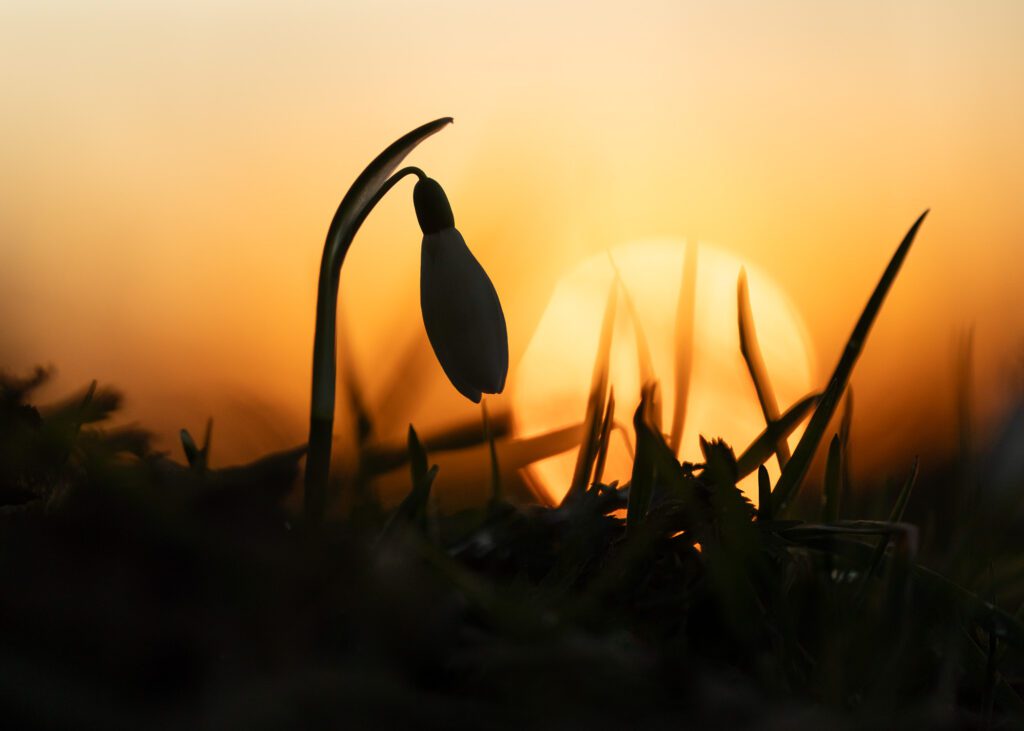
The first sign of spring. A beautiful snowdrop extends from a grassy section on the edge of a local woodland. The sky was perfectly clear, not a cloud in sight – a stark contrast to the weather we’ve seen this week. Anyway, I noticed that the sun was setting on the horizon directly behind this particular snowdrop. I couldn’t resist! A beautiful silhouette tightly composed with my Canon EF 100mm Macro lens.
Moving Away From Social Media
You might also notice that I’m not as active on social media lately and haven’t been for some time. Since ceasing my business interest in photography, I’m under less obligation to entertain social media these days. Personally, I think that most social media platforms have become a toxic environment, and I’m struggling to see the value in entertaining the negativity. I’ll probably go into this in more detail soon when I have decided where to focus my efforts. Until then, I’m unbelievably excited to get back out and enjoy photography. The spark has returned!
Thanks for Reading!
As always, a huge thank you for reading if you made it this far. If you liked reading about my trip to Bowfell, take a look at a couple of photographs I captured from The Band last summer. No doubt I’ll return soon, but until then, I’ll be making the most of the remainder of winter.

